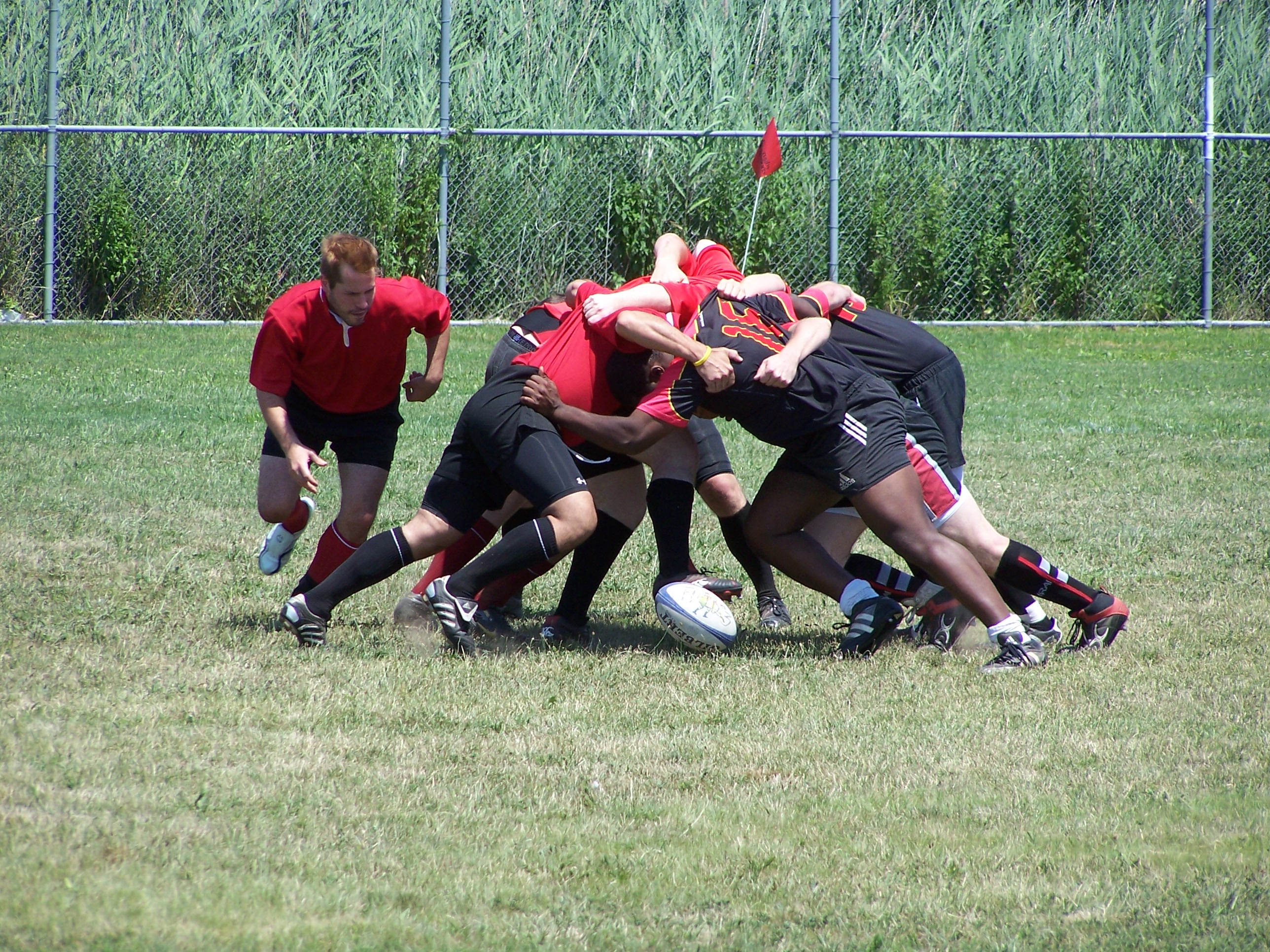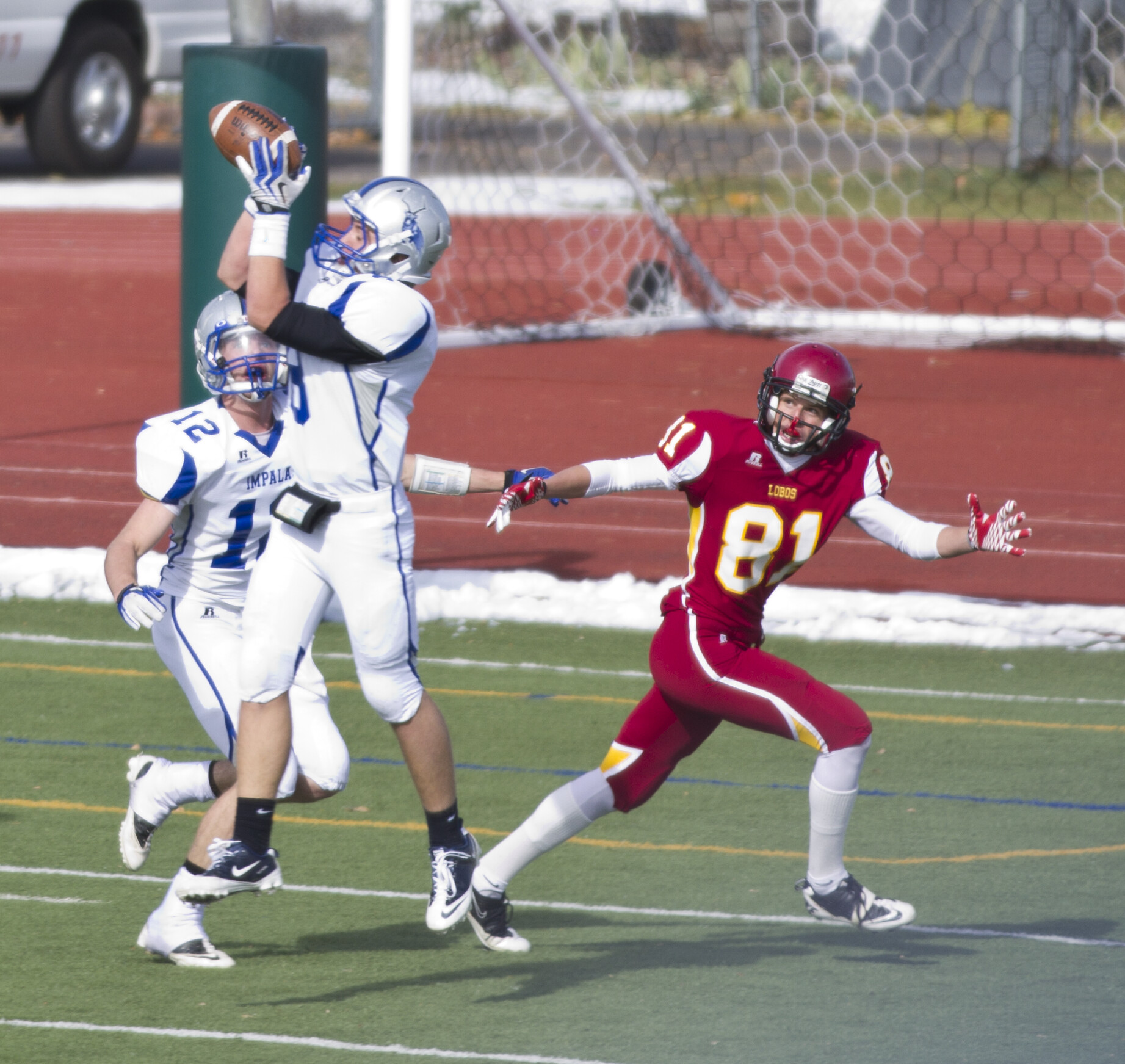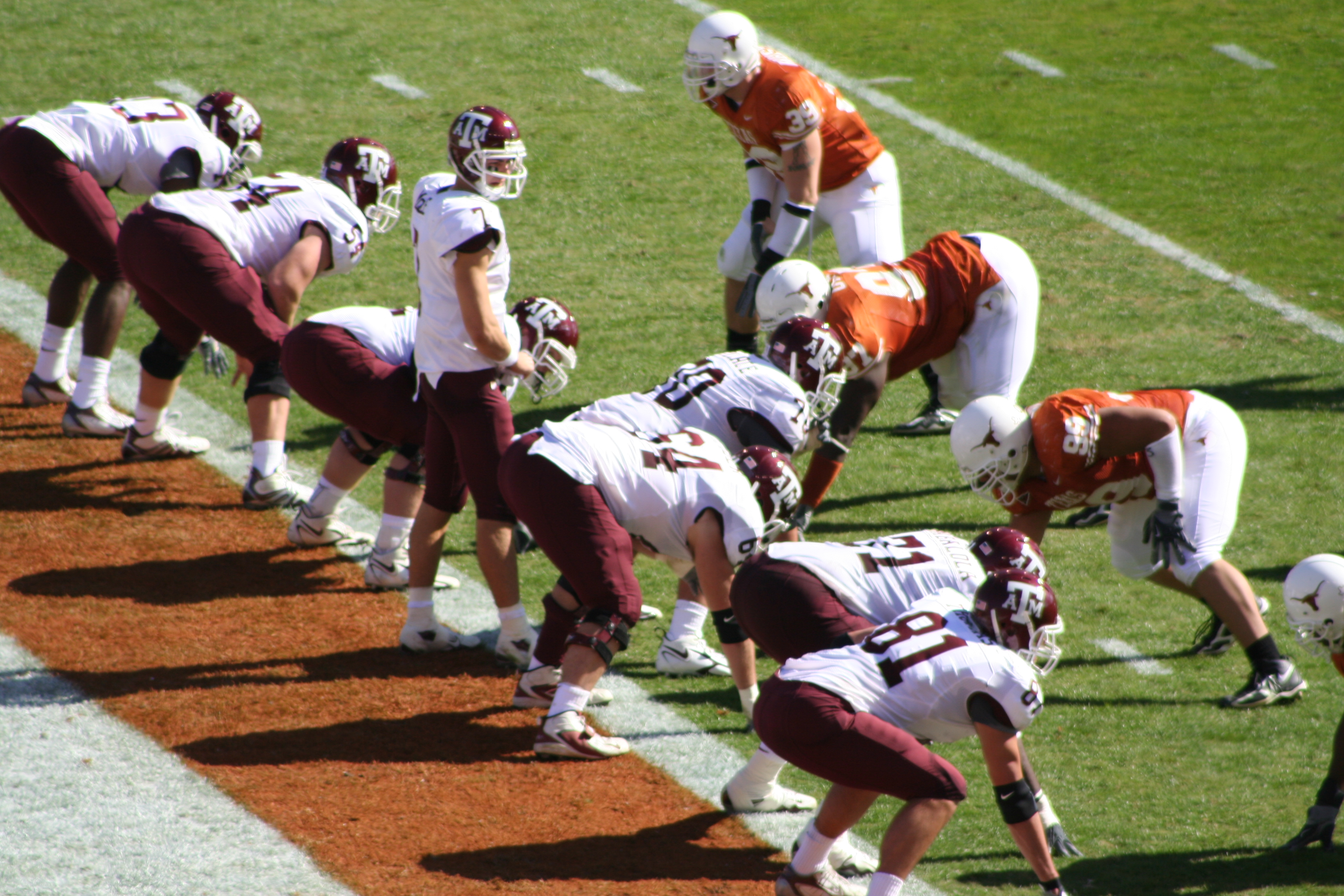|
Comparison Of American Football And Rugby League
A comparison between American football and rugby league is possible because of their shared origins and similar game concepts. Rugby league is arguably the most similar sport to American football after Canadian football: both sports involve the concept of a limited number of downs/tackles and scoring touchdowns/tries takes clear precedence over goal-kicking. Generally, American football games last much longer than 80-minute rugby league matches. Because the field is reset after each tackle in American football, it is much slower-paced than the more hectic rugby league, in which play stops for only as long as it takes the tackled player to get back to his feet and return the ball to play. Another major difference is that only the player with possession of the ball may be interfered with in rugby league; defending players interfering with any other attacking player (and vice versa) will incur a penalty. Passing in the two sports also differs: while Lateral pass, backward passing is ... [...More Info...] [...Related Items...] OR: [Wikipedia] [Google] [Baidu] |
American Football
American football (referred to simply as football in the United States and Canada), also known as gridiron, is a team sport played by two teams of eleven players on a rectangular field with goalposts at each end. The offense, the team with possession of the oval-shaped football, attempts to advance down the field by running with the ball or passing it, while the defense, the team without possession of the ball, aims to stop the offense's advance and to take control of the ball for themselves. The offense must advance at least ten yards in four downs or plays; if they fail, they turn over the football to the defense, but if they succeed, they are given a new set of four downs to continue the drive. Points are scored primarily by advancing the ball into the opposing team's end zone for a touchdown or kicking the ball through the opponent's goalposts for a field goal. The team with the most points at the end of a game wins. American football evolved in the United States, ... [...More Info...] [...Related Items...] OR: [Wikipedia] [Google] [Baidu] |
Rugby League Positions
A rugby league team consists of thirteen players on the field, with 4 substitutes on the bench. Each of the thirteen players is assigned a position, normally with a standardised number, which reflects their role in attack and defence, although players can take up any position at any time. Players are divided into two general types, forwards and backs. Forwards are generally chosen for their size and strength. They are expected to run with the ball, to attack, and to make tackles. Forwards are required to improve the team's field position thus creating space and time for the backs. Backs are usually smaller and faster, though a big, fast player can be of advantage in the backs. Their roles require speed and ball-playing skills, rather than just strength, to take advantage of the field position gained by the forwards. Typically forwards tend to operate in the centre of the field, while backs operate nearer to the touch-lines, where more space can usually be found. Names and numberi ... [...More Info...] [...Related Items...] OR: [Wikipedia] [Google] [Baidu] |
Scrum (rugby)
A scrummage, commonly simply known as a scrum, is a method of restarting play in rugby football that involves players packing closely together with their heads down and attempting to gain possession of the ball. Depending on whether it is in rugby union or rugby league, the scrum is used either after an accidental infringement or when the ball has gone out of play. Scrums occur more often, and are now of greater importance, in union than in league. Starting play from the line of scrimmage in gridiron football is derived from the scrum. In both forms of rugby, a scrum is formed by the players who are designated forwards binding together in three rows. The scrum then 'engages' with the opposition team so that the players' heads are interlocked with those of the other side's front row. In rugby union the initiation of the process is verbally coordinated by the referee who calls 'crouch, bind, set' as of 2013 (formerly 'crouch, touch, pause, engage', 'crouch and hold, engage' before ... [...More Info...] [...Related Items...] OR: [Wikipedia] [Google] [Baidu] |
Interception
In ball-playing competitive team sports, an interception or pick is a move by a player involving a pass of the ball—whether by foot or hand, depending on the rules of the sport—in which the ball is intended for a player of the same team but caught by a player of the team on defense, who thereby usually gains possession of the ball for their team. It is commonly seen in football, including American and Canadian football, as well as association football, rugby league, rugby union, Australian rules football and Gaelic football, as well as any sport by which a loose object is passed between players toward a goal. In basketball, a pick is called a steal. American/Canadian football In American football and Canadian football, an interception occurs when a forward pass that has not yet touched the ground is caught by a player of the opposing defensive team. This leads to an immediate change of possession during the play, and the defender who caught the ball can immediately attem ... [...More Info...] [...Related Items...] OR: [Wikipedia] [Google] [Baidu] |
Punt (gridiron Football)
In gridiron football, a punt is a kick performed by dropping the ball from the hands and then kicking the ball before it hits the ground. The most common use of this tactic is to punt the ball downfield to the opposing team, usually on the final down, with the hope of giving the receiving team a field position that is more advantageous to the kicking team when possession changes. The result of a typical punt, barring any penalties or extraordinary circumstances, is a first down for the receiving team. A punt is not to be confused with a drop kick, a kick ''after'' the ball hits the ground, now rare in both American and Canadian football. The type of punt leads to different motion of the football. Alex Moffat invented the now-common spiral punt, as opposed to end-over-end. Description A punt in gridiron football is a kick performed by dropping the ball from the hands and then kicking the ball before it hits the ground. In football, the offense has a limited number of downs, or ... [...More Info...] [...Related Items...] OR: [Wikipedia] [Google] [Baidu] |
Center (gridiron Football)
Center or Centre (C) is a position in gridiron football. The center is the innermost Lineman (American football), lineman of the offensive line on a football team's Offense (sports), offense. The center is also the player who passes (or "Snap (gridiron football), snaps") the ball between his legs to the quarterback at the start of each Play from scrimmage, play. The importance of centers for a football team has increased, due to the re-emergence of 3–4 defenses. According to Baltimore Ravens general manager Ozzie Newsome, "you need to have somebody who can neutralize that nose tackle. If you don't, everything can get screwed up. Your running game won't be effective and you'll also have somebody in your quarterback's face on every play." Roles The center's first role is to pass the football to the quarterback. This exchange is called a snap. Most offensive schemes make adjustments based on how the defensive line and linebackers align themselves in relation to the offensive line, ... [...More Info...] [...Related Items...] OR: [Wikipedia] [Google] [Baidu] |
Snap (American Football)
A snap (colloquially called a "hike", "snapback", or "pass from center") is the backward passing of the ball in gridiron football at the start of play from scrimmage. Action The ball begins on the ground with its long axis parallel to the sidelines of the field, its ends marking each team's line of scrimmage in American football; in Canadian football, the line of scrimmage of the team without the ball is 1 yard past their side of the ball. The player snapping the ball (known officially as the "snapper" in rule books) delivers the ball to another player, and that action is the snap. The snapper may hand, throw, or even roll the ball to the other player. The snap must be a quick and continuous movement of the ball by one or both hands of the snapper, and the ball must leave the snapper's hands. The various rules codes have additional requirements, all of which have the effect of requiring the ball to go backward. The snapper almost always passes the ball between his legs, but on ... [...More Info...] [...Related Items...] OR: [Wikipedia] [Google] [Baidu] |
Rush (gridiron Football)
Rushing is an action taken by the offense that means to advance the ball by running with it, as opposed to passing, or kicking. Running Rushing, on offense, is running with the ball when starting from behind the line of scrimmage with an intent of gaining yardage. While this usually means a running play, any offensive play that does not involve a forward pass is a rush - also called a run. It is usually done by the running back after a handoff from the quarterback, although quarterbacks and wide receivers can also rush. The quarterback will usually run when a passing play has broken down – such as when there is no receiver open to catch the ball – and there is room to run down the field. A team with a quarterback who is fast and skilled at running may regularly call intentional running plays for that quarterback, but this is rare due to the increased risk of injury. A wide receiver can act as a rusher on several kinds of plays, such as on a reverse, on an end-around, ... [...More Info...] [...Related Items...] OR: [Wikipedia] [Google] [Baidu] |
Rugby League Gameplay
Like most forms of modern football, rugby league football is played outdoors on a rectangular grass field with goals at each end that are to be attacked and defended by two opposing teams. The rules of rugby league have changed significantly over the decades since rugby football split into the league and union codes. This article details the modern form of the game and how it is generally played today, however rules do vary slightly between specific competitions. Basics Field A game of rugby league consists of two forty-minute halves, played by two teams on a rectangular grass field 120 metres long and 58–68 metres wide, depending on the individual ground. In the middle of the field is the 50-metre "halfway" line. Each side of the field, on either side of the 50-metre line, is identical. 10 metres from the 50-metre line is the 40-metre line, followed by the 30, 20, 10-metre and goal or "try" lines. This makes up 100 metres of field that is used for general play. At the m ... [...More Info...] [...Related Items...] OR: [Wikipedia] [Google] [Baidu] |
Rugby Union
Rugby union, commonly known simply as rugby, is a close-contact team sport that originated at Rugby School in the first half of the 19th century. One of the two codes of rugby football, it is based on running with the ball in hand. In its most common form, a game is played between two teams of 15 players each, using an oval-shaped ball on a rectangular field called a pitch. The field has H-shaped goalposts at both ends. Rugby union is a popular sport around the world, played by people of all genders, ages and sizes. In 2014, there were more than 6 million people playing worldwide, of whom 2.36 million were registered players. World Rugby, previously called the International Rugby Football Board (IRFB) and the International Rugby Board (IRB), has been the governing body for rugby union since 1886, and currently has 101 countries as full members and 18 associate members. In 1845, the first laws were written by students attending Rugby School; other significant even ... [...More Info...] [...Related Items...] OR: [Wikipedia] [Google] [Baidu] |
Playing Rugby League
Like most forms of modern football, rugby league football is played outdoors on a rectangular grass field with goals at each end that are to be attacked and defended by two opposing teams. The rules of rugby league have changed significantly over the decades since rugby football split into the league and union codes. This article details the modern form of the game and how it is generally played today, however rules do vary slightly between specific competitions. Basics Field A game of rugby league consists of two forty-minute halves, played by two teams on a rectangular grass field 120 metres long and 58–68 metres wide, depending on the individual ground. In the middle of the field is the 50-metre "halfway" line. Each side of the field, on either side of the 50-metre line, is identical. 10 metres from the 50-metre line is the 40-metre line, followed by the 30, 20, 10-metre and goal or "try" lines. This makes up 100 metres of field that is used for general play. At the m ... [...More Info...] [...Related Items...] OR: [Wikipedia] [Google] [Baidu] |
Line Of Scrimmage
In gridiron football, a line of scrimmage is an imaginary transverse line (across the width of the field) beyond which a team cannot cross until the next play has begun. Its location is based on the spot where the ball is placed after the end of the most recent play and following the assessment of any penalty yards. History The line of scrimmage first came into use in 1880. Developed by Walter Camp (who introduced many innovations that are part of the modern game of American football), it replaced a contested scrimmage that had descended from the game's rugby roots. This uncontested line of scrimmage would set into motion many more rules that led to the formation of the modern form of gridiron football (although the Canadian rules were developed independently of the American game, despite their similarities). Dimensions A line of scrimmage is parallel to the goal lines and touches one edge of the ball where it sits on the ground before the snap. In American football, the ... [...More Info...] [...Related Items...] OR: [Wikipedia] [Google] [Baidu] |

.jpg)





